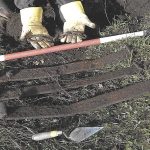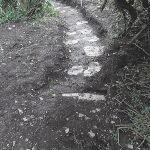
A Heritage Area and Local Nature Reserve

A Heritage Area and Local Nature Reserve
By Tony Beardsell and Martyn Young

This is on British Waterways land (Now Canal And River Trust); dredged material was deposited here from the Middleton dock between the dock and tramway.
The tally house by the dock and its tramway are still to be surveyed. At the end of the tramway which has been severed by the entrance road, material has been put back to taper the end of the embankment.
A section of check rail from the tramway system is visible close to the Bridgeman family dock.
Additions to Area 3
The following areas have been included to extend the Area 3 survey:
- English tramway behind the stable block
- Middleton dock area, with tramway systems
- Tally house and embankment
- Rock sidings in both Middleton and Bridgeman areas.
Bridgeman Tramway
The tramway which passes behind the stable block on its way to the family dock has always had a trickle of water flowing along its surf ace. The ballast surface was generally flat with the occasional sleeper and spikes just breaking the surface. However, the summer of 2012 was to make a big impact.
Heavy rainfall the autumn before, a wet spring/summer started to etch away the surface. On 24 September 2012, 58 millimetres fell in just over 2 hours scouring the surface away, popping out three sleepers and bringing down a vast quantity of shingle. (see Bridgeman Tramway image).
A quick survey and walk up the tramway rescued 16 tramway spikes, a fish plate, nuts & bolts and a wagon brake chain and peg. There are still at least four sleepers in place and hopefully adjusting the water course upstream will prevent further erosion.
Canal Wharf Survey
The 1887 map (below), shows the loading wharf parallel to the canal, to the east of the Welsh Dock. A piece of check rail, three track bars, (marked in red) a section of chain and many tramway spikes have been found. The inclined wharf is 170′ in length, 6-8′ wide, and has a retaining wall 3-4′ high with 12° of batter. The photo (below, top left), was taken on 2 June 2005.
A look at the tramway which curves to the south and east of the Middleton dock, marked on the 1887 map, which had gone by the 1902 edition, still revealed 3 track bars alongside the dock, 4 sets of sleepers with spikes attached, a small chain, nuts, part of a steel plate and two bits of a fish plate, plus 30 assorted spikes lying in the loose on the surface of the tramway.
.
2nd February 2015
A second look deeper in the undergrowth revealed a shovel, a tramway rail tipper end section, 3 main line fish plates, a 18″ thick bent plate, 2 chain links (see Finds Map below) spike, washer & nut, and a forth 2′ tramway track bar. The track bed contained a lot of ash and unburnt coal in the ballast.
Stone Blocks and Cast Iron Rails
A very early tramway built just after 1806
For many years it has been impossible to walk the full length of the tramway illustrated by the orange line on the map below. Intense foliage, fallen trees, brambles and ivy growth had blocked the path. See the photograph below taken in 2005 of the wharf tally hut embedded in the end of the tramway.
A working party from British Waterways (now CRT) had cleared the embankment in the autumn of 2014 and revealed a line of stone blocks on the inboard side of the curved tramway. A total of 43 stone blocks, pins and a piece of cast iron plate way have been found.
In the wharf section of area 3 between the two docks where the ground slopes away to the canal, a well built, stone faced embankment maintains a level plate way/tramway which has a tally hut embedded at the western end. The tally hut had a door and window, (iron grills are in place now), a vaulted ceiling and a fireplace across the front corner of the building. The structure is on the 1863 and 1888 maps, but out of use by 1901.
The plate way embankment is 207′ long and 9′ high, with a wide radius of turn, (difficult to turn short lengths of cast iron plates on stone blocks smoothly through 90°) with the last 48′ ending parallel to the canal.
Stone blocks are visible all the way down the Welsh Tramway constructed in 1806 to the canal. Several blocks have been found on the stone-faced embankment tramway, some with three holes (see photo above) and many with distinctive iron pins in place.
Wharf Embankment
Interesting find at 50’5″.
A section of cast iron L shaped tramway plate being lifted by a stone block at 50′ 5″ from the datum with two iron flat plate packing pieces, which is now on display in stable block.
A total of 43 stone blocks were found just under the ivy, the first at 36′ 5″ from the datum point, through to the final one at 187′ 7″.
Many were in pairs on the curved part of the tramway from 46′ to 70′ 6” (see Figure 30).
Details of the blocks are:
- 28 blocks with 1 pin hole
- 8 blocks with 2 pin holes
- 3 blocks with 3 pin holes
- 2 blocks with 4 pin holes
- 1 block with 5 pin holes
- 1 block with 6 pin holes
14 stone blocks were found with pins in the hole or lying on the surface of the block. As well as traces of coal many spikes, pins, nuts, bolts, shattered cast iron plate bits, and a piece of cast iron inverted T rail were found.
There are variations in stone block spacing from the canal straight, around the curve and onto the straight to the stable block.
The gauge is 17″@ 59′ to 64’8″, (the first 6 set of blocks discovered). There is gauge widening at 80′ & 84′ 7″, which is not optical distortion, and gauge narrowing at 46’3″. Wear and tear, stone robbing, tree root damage and the change from cast iron plates to inverted T rail may account for some variation.





















